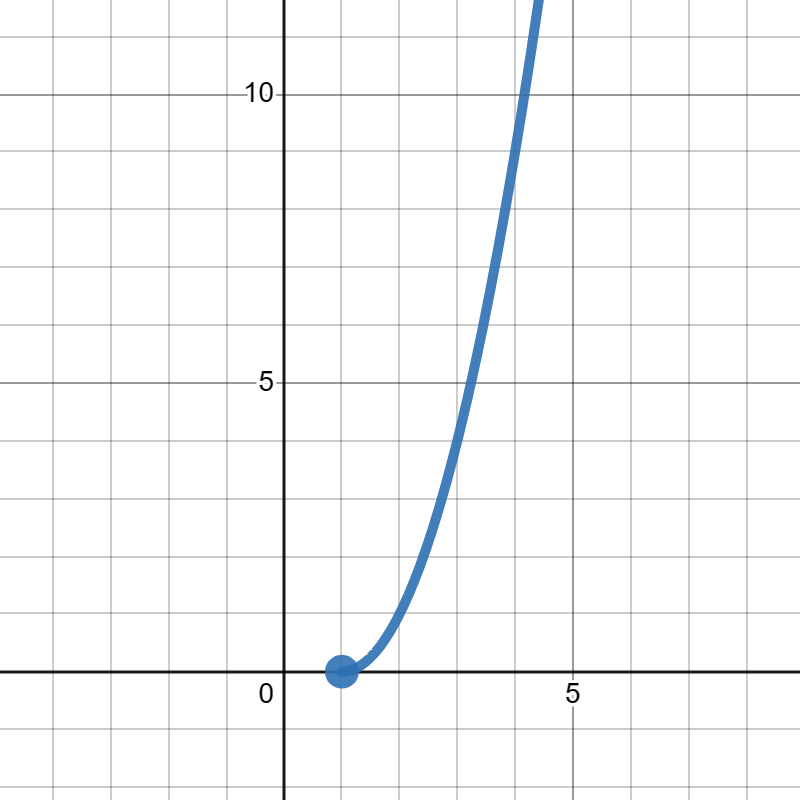Exercises 4.3 Practice Problems
1.
Suppose \(f(x) = 2x+1\text{.}\)
Evaluate each of the following:
\(\displaystyle f^{-1}(0)\)
\(\displaystyle f^{-1}(4)\)
\(\displaystyle f^{-1}(9)\)
\(\displaystyle f^{-1}(1)\)
\(\displaystyle f^{-1}(10)\)
\(\displaystyle f^{-1}(0)=\frac{-1}{2}\)
\(\displaystyle f^{-1}(4)=\frac{3}{2}\)
\(\displaystyle f^{-1}(9)=4\)
\(\displaystyle f^{-1}(1)=0\)
\(\displaystyle f^{-1}(10)=\frac{9}{2}\)
2.
Suppose \(f(x) = 3x-2\text{.}\)
Evaluate each of the following:
\(\displaystyle f^{-1}(1)\)
\(\displaystyle f^{-1}(3)\)
\(\displaystyle f^{-1}(0)\)
\(\displaystyle f^{-1}(5)\)
\(\displaystyle f^{-1}(4)\)
\(\displaystyle f^{-1}(1)=1\)
\(\displaystyle f^{-1}(3)=\frac{5}{3}\)
\(\displaystyle f^{-1}(0)=\frac{2}{3}\)
\(\displaystyle f^{-1}(5)=\frac{7}{3}\)
\(\displaystyle f^{-1}(4)=2\)
3.
Suppose \(f(x)\) is given in the graph below.

Evaluate each of the following:
\(\displaystyle f^{-1}(0)\)
\(\displaystyle f^{-1}(1)\)
\(\displaystyle f^{-1}(9)\)
\(\displaystyle f^{-1}(2)\)
\(\displaystyle f^{-1}(4)\)
\(\displaystyle f^{-1}(0)=1\)
\(\displaystyle f^{-1}(1)=2\)
\(\displaystyle f^{-1}(9)=5\)
\(\displaystyle f^{-1}(2)=3\)
\(\displaystyle f^{-1}(4)=4\)
4.
Suppose \(g(x)\) is given in the table below.
| \(x\) | \(-1\) | \(3\) | \(2\) | \(5\) | \(4\) |
| \(g(x)\) | \(0\) | \(3\) | \(7\) | \(1\) | \(2\) |
Evaluate each of the following:
\(\displaystyle g^{-1}(0)\)
\(\displaystyle g^{-1}(1)\)
\(\displaystyle g^{-1}(3)\)
\(\displaystyle g^{-1}(7)\)
\(\displaystyle g^{-1}(2)\)
\(\displaystyle g^{-1}(0)=-1\)
\(\displaystyle g^{-1}(1)=5\)
\(\displaystyle g^{-1}(3)=3\)
\(\displaystyle g^{-1}(7)=2\)
\(\displaystyle g^{-1}(2)=4\)
5.
Suppose \(g(x)\) is given in the table below.
| \(x\) | \(0\) | \(2\) | \(3\) | \(5\) | \(4\) |
| \(g(x)\) | \(0\) | \(1\) | \(7\) | \(5\) | \(2\) |
Evaluate each of the following:
\(\displaystyle g^{-1}(0)\)
\(\displaystyle g^{-1}(1)\)
\(\displaystyle g^{-1}(2)\)
\(\displaystyle g^{-1}(7)\)
\(\displaystyle g^{-1}(5)\)
\(\displaystyle g^{-1}(0)=0\)
\(\displaystyle g^{-1}(1)=2\)
\(\displaystyle g^{-1}(2)=4\)
\(\displaystyle g^{-1}(7)=3\)
\(\displaystyle g^{-1}(5)=5\)
6.
Suppose \(f(x) = 5x+7.\)
Find a formula for the inverse.
\(f^{-1}(x)=\frac{x-7}{5}\)
7.
Suppose \(g(x) = \frac{x+3}{2x-4}\text{.}\)
Find a formula for the inverse.
\(g^{-1}(x)=\frac{3+4x}{2x-1}\)
8.
Suppose \(f(x) = x^3 -3\text{.}\)
Find a formula for the inverse.
\(f^{-1}(x)=\sqrt[3]{x+3}\)
9.
Suppose \(g(x) = \frac{2x+3}{5x-4}\text{.}\)
Find a formula for the inverse.
\(g^{-1}(x)=\frac{3+4x}{5x-2}\)
10.
Suppose \(g(x) = (x+1)^5\text{.}\)
Find a formula for the inverse.
\(g^{-1}(x)=\sqrt[5]{x}-1 \)
11.
Suppose \(g(x) = \frac{2}{7x-3}\text{.}\)
Find a formula for the inverse.
\(g^{-1}(x)=\frac{2+3x}{7x}\)
12.
Suppose \(g(x) = \sqrt[7](x) + 8\text{.}\)
Find a formula for the inverse.
\(g^{-1}(x)= (x-8)^{7}\)